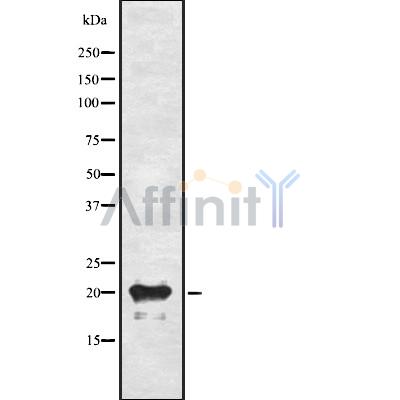ADM Antibody - #DF8501
| Product: | ADM Antibody |
| Catalog: | DF8501 |
| Description: | Rabbit polyclonal antibody to ADM |
| Application: | WB |
| Reactivity: | Human, Mouse, Rat |
| Prediction: | Pig, Bovine, Horse, Sheep, Rabbit, Dog |
| Mol.Wt.: | 20 kDa; 20kD(Calculated). |
| Uniprot: | P35318 |
| RRID: | AB_2841707 |
Product Info
*The optimal dilutions should be determined by the end user. For optimal experimental results, antibody reuse is not recommended.
*Tips:
WB: For western blot detection of denatured protein samples. IHC: For immunohistochemical detection of paraffin sections (IHC-p) or frozen sections (IHC-f) of tissue samples. IF/ICC: For immunofluorescence detection of cell samples. ELISA(peptide): For ELISA detection of antigenic peptide.
Cite Format: Affinity Biosciences Cat# DF8501, RRID:AB_2841707.
Fold/Unfold
Adm; ADM precursor; ADML_HUMAN; AM; PAMP; Preproadrenomedullin; Proadrenomedullin N-20 terminal peptide; Proadrenomedullin N20 terminal peptide; ProAM N terminal 20 peptide; ProAM N-terminal 20 peptide; ProAM N20; ProAM-N20; ProAMN20;
Immunogens
A synthesized peptide derived from human ADM, corresponding to a region within N-terminal amino acids.
Highest levels found in pheochromocytoma and adrenal medulla. Also found in lung, ventricle and kidney tissues.
- P35318 ADML_HUMAN:
- Protein BLAST With
- NCBI/
- ExPASy/
- Uniprot
MKLVSVALMYLGSLAFLGADTARLDVASEFRKKWNKWALSRGKRELRMSSSYPTGLADVKAGPAQTLIRPQDMKGASRSPEDSSPDAARIRVKRYRQSMNNFQGLRSFGCRFGTCTVQKLAHQIYQFTDKDKDNVAPRSKISPQGYGRRRRRSLPEAGPGRTLVSSKPQAHGAPAPPSGSAPHFL
Predictions
Score>80(red) has high confidence and is suggested to be used for WB detection. *The prediction model is mainly based on the alignment of immunogen sequences, the results are for reference only, not as the basis of quality assurance.
High(score>80) Medium(80>score>50) Low(score<50) No confidence
Research Backgrounds
AM and PAMP are potent hypotensive and vasodilatator agents. Numerous actions have been reported most related to the physiologic control of fluid and electrolyte homeostasis. In the kidney, am is diuretic and natriuretic, and both am and pamp inhibit aldosterone secretion by direct adrenal actions. In pituitary gland, both peptides at physiologically relevant doses inhibit basal ACTH secretion. Both peptides appear to act in brain and pituitary gland to facilitate the loss of plasma volume, actions which complement their hypotensive effects in blood vessels.
Secreted.
Highest levels found in pheochromocytoma and adrenal medulla. Also found in lung, ventricle and kidney tissues.
Belongs to the adrenomedullin family.
References
Restrictive clause
Affinity Biosciences tests all products strictly. Citations are provided as a resource for additional applications that have not been validated by Affinity Biosciences. Please choose the appropriate format for each application and consult Materials and Methods sections for additional details about the use of any product in these publications.
For Research Use Only.
Not for use in diagnostic or therapeutic procedures. Not for resale. Not for distribution without written consent. Affinity Biosciences will not be held responsible for patent infringement or other violations that may occur with the use of our products. Affinity Biosciences, Affinity Biosciences Logo and all other trademarks are the property of Affinity Biosciences LTD.
